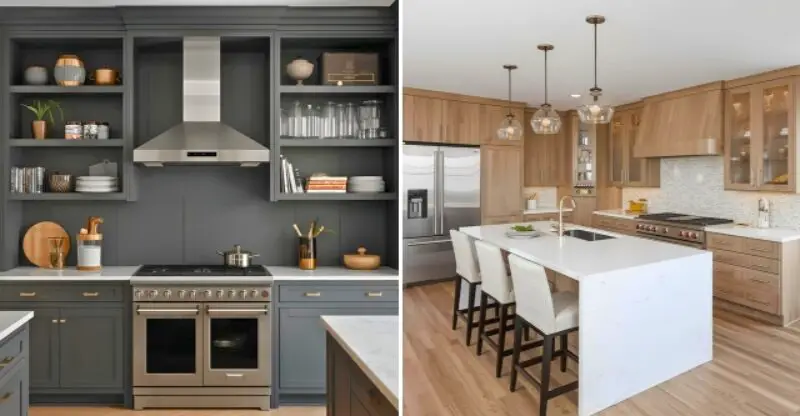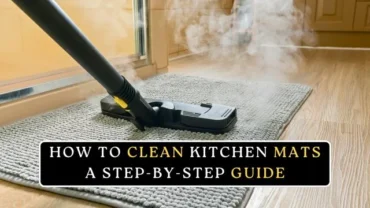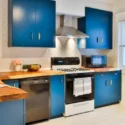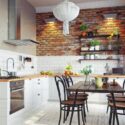Open vs Closed Shelving: Which Works Best for You?
The great kitchen debate: open shelving versus closed cabinets. This single decision can dramatically shape the look, feel, and functionality of your space. Do you envision a bright, gallery-like kitchen that showcases your personality, or do you crave a calm, streamlined sanctuary where everything is neatly tucked away? There’s no single right answer, but understanding the benefits and drawbacks of each style is key to creating a kitchen you’ll love.
Choosing your storage is a critical step, especially if you’re undertaking a full kitchen remodel on a budget, as it impacts both your finances and your daily routine. Let’s dive deep into each option to help you make the best choice for your home.
The Allure of Open Shelving
Open shelving replaces traditional upper cabinets with wall-mounted shelves, creating an airy, spacious feel. This approach turns your everyday items—dishes, glassware, cookbooks—into decorative elements, infusing the room with character and style. It’s a look that feels modern, accessible, and incredibly personal.
The primary advantage is convenience; your most-used items are always within arm’s reach, streamlining your cooking and prep time. This style is also fantastic for showcasing other design elements, as open shelves won’t hide a stunning wall treatment you’ve worked hard on, which is something to consider if you plan to tile a backsplash in a kitchen.
However, this breezy aesthetic comes with a catch: it demands organization. With everything on display, there’s no hiding clutter. Messy or mismatched items can make the entire kitchen feel chaotic. Furthermore, shelves and their contents are exposed to airborne dust and grease, requiring more frequent cleaning. It’s one of those crucial details that are among the top things I wish I knew before renovating my kitchen.
The Classic Comfort of Closed Cabinets
Closed cabinets are the cornerstone of traditional kitchen design for a reason. They offer a clean, uncluttered aesthetic by concealing everything behind a door. This allows for maximum storage flexibility, as you don’t have to worry about whether your collection of pots, pans, and mismatched mugs is “display-worthy.”
Cabinets provide a serene and orderly look, which can make a busy space feel more peaceful. They also protect your kitchenware from dust and grime, reducing your cleaning workload. With an endless variety of styles and finishes available, from traditional to ultra-modern, cabinets can define your kitchen’s entire look. They offer a perfect canvas, whether you’re learning how to decorate a kitchen with oak cabinets for a classic feel or choosing a bold new color.
On the downside, a wall of solid upper cabinets can make a smaller kitchen feel heavier and more enclosed. They are also typically a more significant financial investment than shelving. And, as anyone who has emptied a cabinet knows, items can easily get lost in the back, out of sight and out of mind. Even in a larger space, like when considering 9 pro tips for building an outdoor kitchen, the choice of storage can make or break the flow.
Open Shelving: A Closer Look
When styled correctly, open shelving can be a showstopper. It forces you to be intentional about what you own and keep, which can be a welcome exercise in minimalism.
On the other hand, the constant need for tidiness can be a real challenge for busy families. As the design experts at HGTV suggest, the key is to be realistic about your lifestyle. If you’re not someone who enjoys styling and constant organization, open shelves could become a source of stress rather than joy.
For a Sleek Look: Americanflat Floating Shelves
If you’re leaning towards open shelving, a minimalist design like these floating shelves offers a clean, contemporary look. They blend seamlessly into the wall, letting your dishware be the star.
Pros:
- Simple, modern aesthetic
- Easy to install
- Sturdy enough for everyday items
Cons:
- Not suitable for extremely heavy cookware
- Requires regular dusting
Closed Cabinets: Weighing the Benefits
The peace of mind that comes with closing a door on clutter cannot be overstated. Cabinets are the practical workhorse of the kitchen, allowing for high-density storage that keeps your space looking polished. They also offer a fantastic opportunity to play with color and hardware. You can follow the latest trends by exploring what’s replacing green kitchens in 2025 or learn how to use 6 decorative color ideas to jazz up a kitchen with neutral cabinets to refresh your space.
However, consider the physical and visual weight they add. In a compact kitchen, too many upper cabinets can feel overwhelming. It’s a balance between maximizing storage and maintaining an open, inviting atmosphere.
For Maximum Storage: Sauder HomePlus Storage Cabinet
For those who value function and capacity above all, a pantry-style cabinet like this one is a game-changer. It can house small appliances, dry goods, and extra serving ware, keeping your main kitchen area free for daily activities.
Pros:
- Ample, adjustable storage
- Keeps clutter completely out of sight
- Durable and well-constructed
Cons:
- Assembly can be time-consuming
- Its large size requires dedicated floor space
Making Your Choice Work: Organization is Key
Whether you opt for shelves, cabinets, or a mix of both, thoughtful organization is what makes a kitchen truly functional. Take kitchen towels, for example. A simple strategy like file-folding them in a drawer with dividers keeps them neat and easy to grab. In an open-shelf design, you might roll them and store them in a decorative basket.
A towel bar on the end of an island is another popular and practical solution. If you’re exploring that possibility, you’ll find plenty of inspiration in these 15 small kitchen island ideas that inspire. And if you’re debating functionality, you should consider if you should you add a sink to your kitchen island?. For those without an island, don’t forget that some of the 11 best kitchen carts for small spaces also offer towel bars and extra storage.
Conclusion:
Ultimately, the choice between open shelving and closed cabinets is deeply personal. It depends on your organizational habits, your aesthetic preferences, and the size of your space.
Increasingly, homeowners are realizing they don’t have to choose. A hybrid approach, combining the two styles, often provides the perfect solution. Consider using closed cabinets for the bulk of your storage and adding a few sections of open shelving to display your favorite items and break up the visual weight. This gives you the practical benefits of cabinets with the personality and style of open shelves—the best of both worlds.



